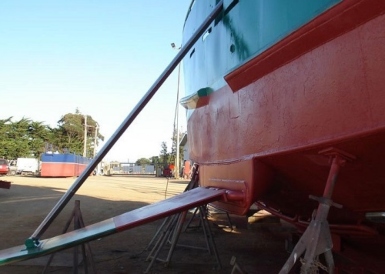
The Australian Maritime Safety Authority (AMSA) has issued a safety alert to raise awareness of the risks associated with the use of fixed fin stabilisers on fishing vessels. It is important to note that incorrect use of fixed fin stabilisers can lead to an accident and even cause a vessel to capsize. Fixed fin stabilisers are also sometimes referred to as batwing stabilisers, anti-roll fins, fixed-arm stabilisers, passive-fin stabilisers, and fixed fins. They are designed to dampen, or reduce, the roll of a vessel, giving it a more comfortable ride in rough weather and possibly even making the vessel run truer. Once installed, fixed fin stabilisers are designed to be lifted up at certain times, such as when operating in shallow waters, crossing a bar, and berthing. Failure to do so carries serious risk. While these stabilisers improve comfort by reducing erratic movement and minimising the roll of a vessel in rough seas, it is of paramount importance to note that they do not improve the stability of a vessel.
Assessing the risks
Some of the known risks associated with the use of these stabilisers include the following.

Managing the risks
Before installing fixed fin stabilisers, assess the risks associated with all of your activities. Also, consider other types of anti-roll devices and make sure you install the best type for your operation.
Alternative anti-roll devices can include the following:
– Paravanes or flopper stoppers
– Bilge keels
– Active fins
– Anti-roll tanks
– Sails
– Gyroscopes.
Importantly, consider the following questions:
– Do we often cross bars or operate in shallow water?
– Does our operation use equipment that will get hooked-up on these devices?
– What type of berthing and unloading infrastructure do we access?
Before fitting fixed fin stabilisers, consult an accredited marine surveyor to assess whether they are the best solution for your vessel’s design and strength. Consider the hull attachment arrangement the fins will have on the stability of the vessel. Also, speak to other skippers who use them regularly to learn from their experience.
The risks and control measures you have identified should be included in your safety management system. These control measures should include things like standard operating procedures and crew training, for example:
– What are the operating limits of this device?
– Does crew need any special training to operate the device safely?
– What procedures should crew follow if risk turns into reality?
Reminder
– Before fitting stabilisers to your vessel, research the different options available. Make sure you get the most suitable type for your vessel and your operation.
– Consult an accredited marine surveyor to ensure the stabilisers are properly designed, engineered and installed.
– Include procedures for the safe use and operation of stabilisers in your safety management system.
– Train crew on how to use the equipment safely.
